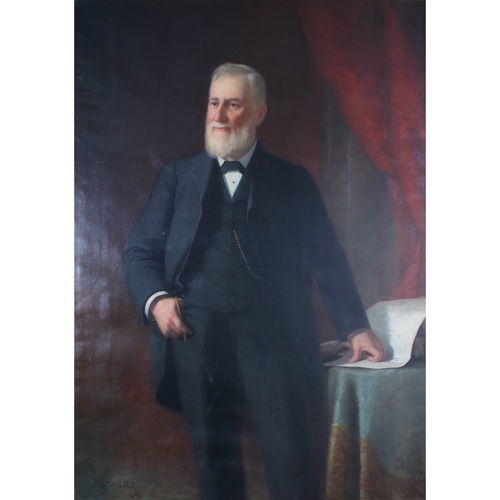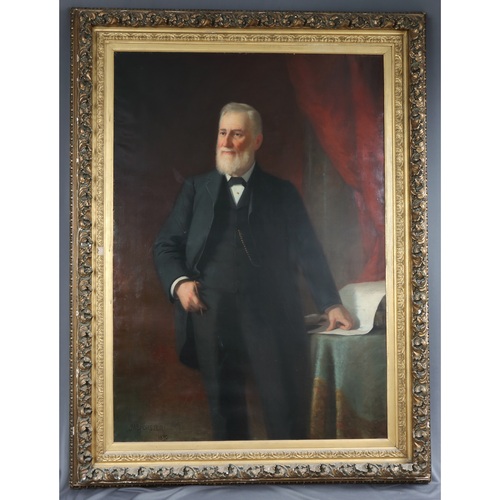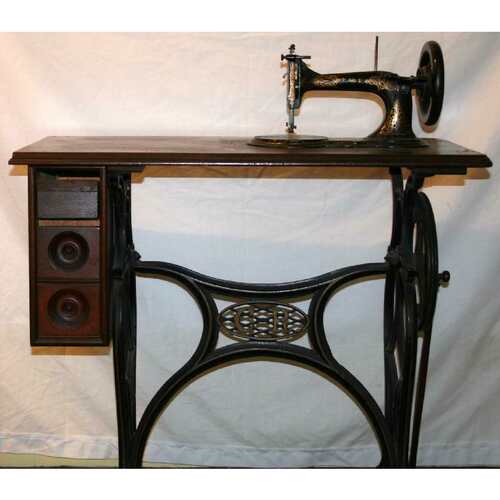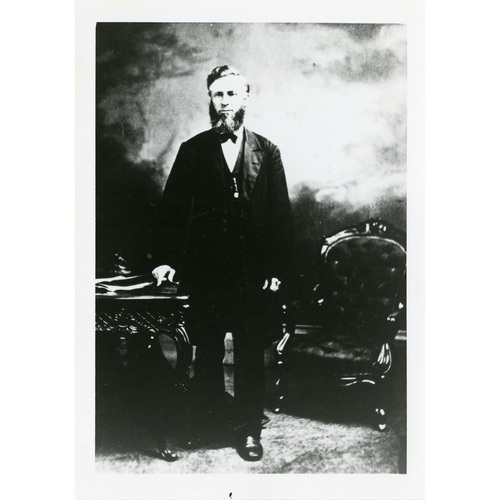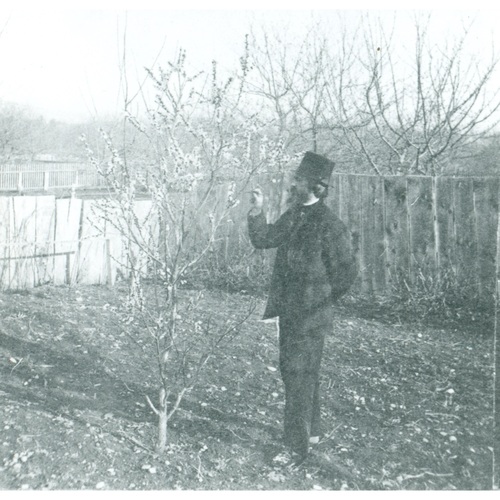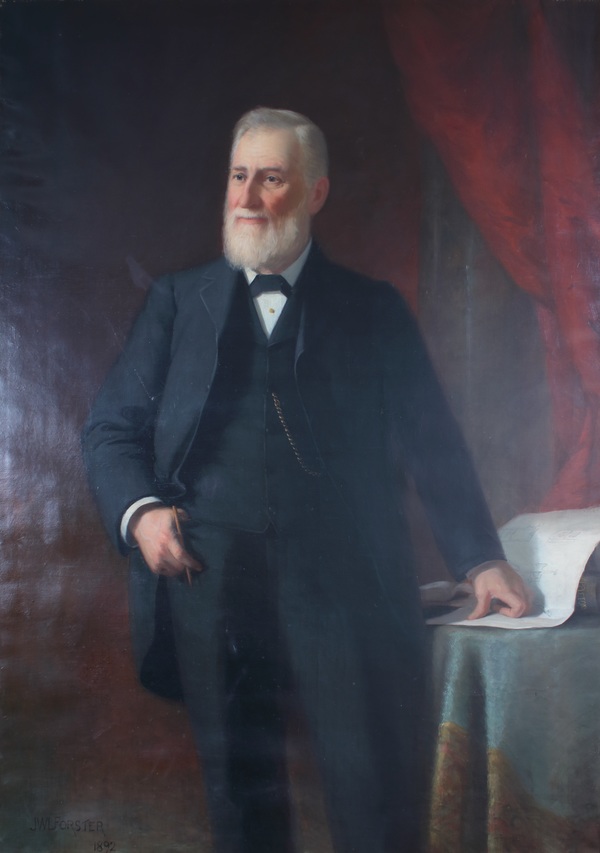
Source: Link
RAYMOND, CHARLES, inventor, manufacturer, politician, and philanthropist; b. 6 Jan. 1826 in Ashburnham, Mass., son of Daniel Raymond, a carpenter and cabinet-maker, and Sarah Greene; m. first 9 Aug. 1847 Mary C. Marston (d. 1869) of Sharon, Vt, and they had one son and two daughters; m. secondly 17 Aug. 1870 Helen Janet Gill of Brattleboro, Vt, and they adopted a son and a daughter; d. 4 Jan. 1904 in Guelph, Ont.
Charles Raymond attended common school at Ashburnham and Fitchburg in north-central Massachusetts. He then spent some time at the Dracut Academy before continuing his education at night school in nearby Lowell, where he was apprenticed as a mechanic at the Massachusetts Cotton Mills. In 1847 he left for Bristol, Vt, and there he embarked on the first of two attempts to develop and market a practical sewing-machine. He produced a single-thread machine but the Singer company patented one first; the cost of litigation forced Raymond to abandon his venture in 1852. Six years later, with William Nettleton in Brattleboro, he manufactured a chain-stitch machine, but again he could not afford to fight Singer.
To obviate such problems, Raymond moved to Montreal in 1860, only to lose a third of his capital in a sewing-machine business there. In 1862 he and 15 tradesmen relocated in Guelph, where he established the Raymond Sewing Machine Company. It soon provided the main competition for Upper Canada’s leading sewing-machine producer, Richard Mott Wanzer* of Hamilton. Initially, the reduction in American competition during the Civil War helped Raymond consolidate his position. Over time he acquired patent rights in Canada and Great Britain for sewing-machines. His business thrived through the careful manipulation of markets in Britain and Europe; in contrast, a number of Canadian competitors failed because of their concentration on the domestic market. By 1870 the Raymond company had a workforce of nearly 80 and an annual output valued at $100,000. Its substantial export of machines to the United States was sharply affected by the trade depression of the late 1870s and by increased American tariffs, but Raymond was able to maintain a competitive advantage because his parts were made locally.
In 1877 Raymond partially withdrew from business because of health problems, but efficient management by supervisors and foremen probably compensated for his temporarily reduced presence. As well, he kept up with business trends. In 1879, for instance, he and two other industrialists had Guelph’s first telephone exchanges. The following year he owned two factories and employed more than 200 workers. On the question of Canadian tariffs, Raymond’s position shifted for reasons that are not totally clear, from opposition in 1877 to increases for revenue purposes (which he argued would be ruinous for sewing-machine manufacturers), to backing in 1882 for protection, to support in 1890–91 for reciprocity.
In 1897 ill health forced Raymond to sell his business, which had been incorporated two years before as the Raymond Manufacturing Company Limited, to J. G. Sully, his foreman, and Christian Kloepfer. He nevertheless remained a mechanic to the end: he was working on a gasoline engine before his death in 1904, following bladder surgery.
As befitted a member of the city’s industrial-commercial élite, Raymond belonged to the Guelph Board of Trade from 1869 and to the Canadian Manufacturers’ Association from 1882. In 1886 he was a director of the Guelph Junction Railway. In civic life he served as a deputy reeve in 1874–75, an alderman in 1886, and a member of the school board; he promoted the construction of Wellington County’s House of Industry and of Guelph’s Central School and general hospital. An advocate of total abstinence, he ran unsuccessfully on a temperance platform as the Conservative candidate in Wellington South in the 1886 provincial election.
One of Guelph’s leading philanthropists and moral crusaders, Raymond reputedly made money to benefit others, and much of his wealth was dispersed before he died; he left an estate worth only $14,550. He was a benefactor of both the Baptist and the Congregational churches. Apparently concluding early on that the Baptist minister was too Calvinistic, he attended the Congregational Church until First Baptist was built in 1873–75. A lay reader there, he was also a deacon, a Sunday-school superintendent, and an executive member of the Baptists’ home and foreign mission boards. Regarded by a contemporary publication as “one of the live christian workers of the city,” he was remembered too as a “friend” to the black congregation of Guelph’s Methodist Episcopal Church.
The portrait of Charles Raymond that hung in Central School (Guelph, Ont.) is now missing, but black and white photographs of it are preserved in the Guelph Public Library, which also has in its possession an etched likeness of the subject. Photographs of Raymond and his sewing-machine factory appear in L. A. Johnson, History of Guelph, 1827–1927 (Guelph, 1977), 255, and his entry in the Canadian biog. dict. includes an engraved portrait.
AO, RG 22, ser.318, no.5170. City of Guelph, City Clerk’s Office, Council, minutes, 1879–1900. Guelph Public Library, Local hist. coll., Guelph churches; McIlwraith coll., Findlay Weaver scrapbook; Shutt coll., including Crowe family scrapbooks, Charles Raymond papers, and the typescript of a speech by Raymond’s great-granddaughter Greta Mary Shutt. NA, RG 31, C1, 1861, 1871, 1881, Guelph (mfm. at Univ. of Guelph Library). Wellington County Arch. (Fergus, Ont.), Wellington County House of Industry, report of inspector and physician, 1878. Woodlawn Cemetery (Guelph), Geneal. files; Reg. Guelph Evening Mercury, centennial ed., 20 July 1927. Guelph Mercury, 1862–1904, including trade ed., 23 June 1894; 7 Jan. 1904. Herald (Guelph), 1862–1904, including illustrated ed., 1895; 5 Jan. 1904. Elizabeth Bloomfield, “Industrial enterprises of the middle Grand valley, 1871,” Historical atlas of Canada, ed. R. C. Harris et al. (3v., Toronto, [1987–93]), 2. C. A. Burrows, The annals of the town of Guelph, 1822–1877 (Guelph, 1877). Directory, Guelph, 1873, 1882/83. M. [J.] Eckmann Brent, “A stitch in time: the sewing machine industry of Ontario, 1860–1897,” Material Hist. Bull. (Ottawa), 10 (1980): 1–30. Guelph, Board of Education, Annual report, 1877 (copy at AO). G. H. Knighton, “A brief history of the Guelph Congregational Church,” ed. G. M. Shutt, OH, 54 (1962): 199–206. D. L. Nash-Chambers, “Two steps forward or one step back? The impact of industrialization on community & family in a small industrial city: Guelph, Ontario, 1861–1881” (phd thesis, Univ. of Guelph, 1988).
Cite This Article
Debra L. Nash-Chambers, “RAYMOND, CHARLES,” in Dictionary of Canadian Biography, vol. 13, University of Toronto/Université Laval, 2003–, accessed December 29, 2025, https://www.biographi.ca/en/bio/raymond_charles_13E.html.
The citation above shows the format for footnotes and endnotes according to the Chicago manual of style (16th edition). Information to be used in other citation formats:
| Permalink: | https://www.biographi.ca/en/bio/raymond_charles_13E.html |
| Author of Article: | Debra L. Nash-Chambers |
| Title of Article: | RAYMOND, CHARLES |
| Publication Name: | Dictionary of Canadian Biography, vol. 13 |
| Publisher: | University of Toronto/Université Laval |
| Year of publication: | 1994 |
| Year of revision: | 1994 |
| Access Date: | December 29, 2025 |


